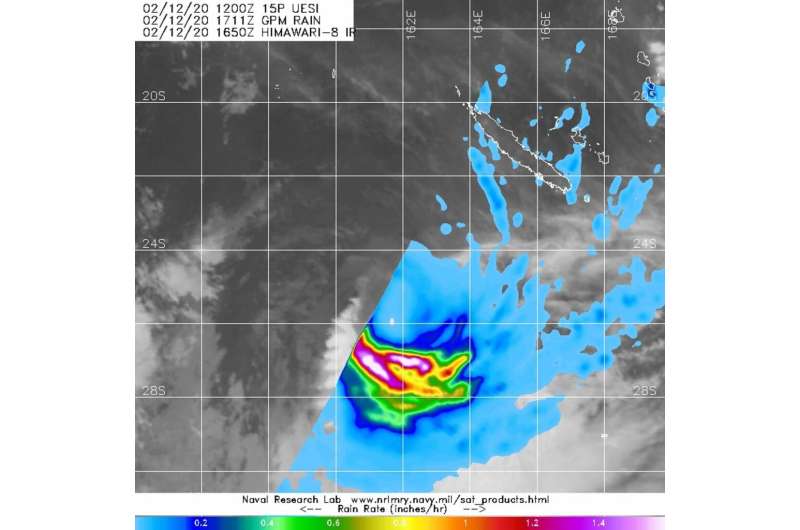NASA finds heavy rain southwest of tropical cyclone Uesi's center

The Global Precipitation Measurement mission or GPM satellite provided a look at the rainfall occurring within Tropical Cyclone Uesi and found heaviest rainfall in the southern quadrant of the storm.
Uesi is in the South Pacific Ocean and has been affecting New Caledonia. New Caledonia is a collectivity of France, located south of Vanuatu and about 1,210 km (750 miles) east of Australia.
The GPM's core satellite passed over Uesi on Feb. 12 at 12:11 p.m. EST (1711 UTC). GPM found heaviest rainfall southwest of the center, falling at a rate of 1.6 inches (40 mm) per hour. Directly south of the center were areas where rainfall rates were falling at a rate of 1 inch (25 mm) per hour. Scattered light rain, falling at less than 0.2 inches (less than 5 millimeters) per hour appeared to be occurring in the rest of the storm.
On Feb 12 at 1 a.m. EST (5 p.m. New Caledonia local time), Meteo-France, which forecasts for New Caledonia, noted that Uesi's maximum sustained winds were near 110 kph (68 mph/59 knots). Uesi was moving to the southwest. It was centered near latitude 23.5 degrees south and longitude 162.8 degrees east, about 450 km (280 miles) west-southwest of Noumea.
Meteo-France noted, "The rains eased in the afternoon, except over the Canala region where the showers are still continuing this evening. In the past 12 hours, we have noted 80 to 130 mm (3.1 to 5.1 inches) in the relief of the South and 80 mm (3.1 inches) in 3 hours in the town of Canala. The wind remains strong with gusts up to 90 kph (60 mph/49 knots) on the chain, on the West Coast and the South. Uesi is moving away from the Caledonian coasts, its influence is still felt throughout the country. Conditions remain disturbed overnight, with a gradual improvement in the north."
Uesi is expected to turn to the southwest and become subtropical after a day or two, off the coast of eastern Australia.
Tropical cyclones/hurricanes are the most powerful weather events on Earth. NASA's expertise in space and scientific exploration contributes to essential services provided to the American people by other federal agencies, such as hurricane weather forecasting.
Provided by NASA's Goddard Space Flight Center





















